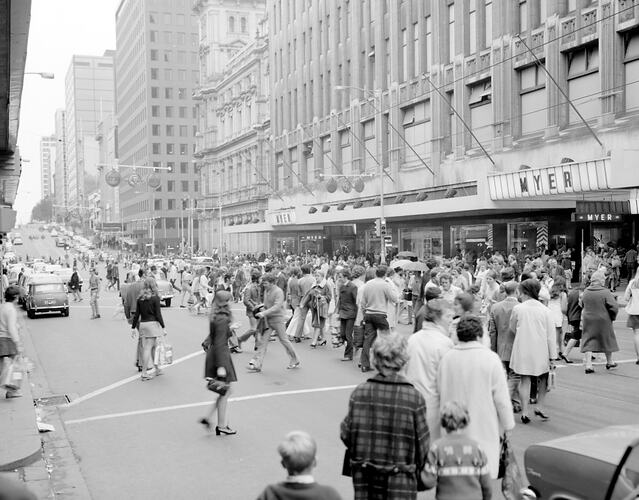Stella Harriet Wakefield (1888-1973) and Wessie Abernethy Wakefield (1897-1980) were the 'maiden aunts' of the Wakefield family. They were from a family of five children, offspring of Walter Warwick Wakefield (1862-1941), and Elizabeth Weston Moore (1865-1947). (Walter's father was involved in the development of the St Kilda railway line, which made money, then lost it during the 1890s depression.) Walter and Elizabeth married in 1887. Their children were all born in St Kilda, except Wessie, who was born in Richmond.
The family had a history of involvement in the retail industry. At the time of his marriage Walter was a partner in Wakefield & Macpherson, a 'licensed grocers and wine and spirit' business at 93 High Street, St Kilda. His partnership with John Macpherson dissolved the following year, but Walter continued the business for some time before becoming a grocer in Hawksburn (The Argus, Monday 3 September 1888, p.14).
Stella was the oldest child of the family and Wessie the youngest. They lived for more than half their lives in the family home, 'Weston', at 45 Rose Street, Armadale. The home was a block-fronted Victorian, too small for the family, and for some years the two youngest brothers, Eric and Melville, slept in a tent in the back yard, with a wooden floor and canvas sides. In later years Wessie slept there.
Claude Walter (1890-1957), the oldest brother, grew up to become a solicitor's clerk. Melville Warwick (1892-1969) also became a clerk, and served in World War I (service #6861), including time in Gallipoli. (Melville was informant Fay Lowe's father.) Eric Weston (1895-1972), became a salesman at Haigh Brothers, a leading Melbourne tailor in Collins Street, and also served in World War I (service #119). His niece, Fay Lowe, recalled that Melville 'claimed' his younger brother during the war, meaning that he successfully applied for Eric to move to his battalion.
Both Stella and Wessie became retail workers. Stella was interested in fashion and was considered to be something of a 'fashion plate'. She initially worked in Flinders Lane, for one of the clothing firms (possibly Sargood Bros, a wholesaler, selling everything from handbags, hosiery and ties to scent, jewellery and razors). She then worked for the department store, Ball & Welch. Wessie started her working life at Moore's department store in Chapel Street, Prahran, then moved to Myer, where she sold laces and ribbons. Fay, then a child, recalls that she had beautifully dressed dolls as a result! Wessie worked for many years at Myer, receiving a silver tray to mark her 25 years of service.
Stella was involved in musical comedy, and played in a theatre in the city. The Argus, 6 August 1910, p.24, lists a performance at the Princess Theatre for two nights, 'La Fille de Madame Angot', performed by the Melbourne Comic Opera Society, in which Stella played Herminy. The Argus described the role on 15 August (p.9) as a 'smaller role.capably filled'. The performance was a fund-raiser, in aid of the Children's Hospital. Stella and Wessie had other social interests too. Wessie played tennis on Saturdays with a group of women. Stella wasn't inclined to sport, but did enjoy watching football games. Both enjoyed Monday night card games.
Stella had a boyfriend with a German name during World War I, but her father forbade the relationship. Stella had no further beaus to the family's knowledge, and remained unmarried for the rest of her life.
Another pair of unmarried women lived opposite Stella and Wessie in Rose Street: the 'Miss Moores'. The four women were friends. The Miss Moores were involved with dressmaking and millinery, and may have had a hand in making the dress donated to Museum Victoria, which does not appear commercially-made.
Wessie did a little sewing, but was probably not sufficiently competent to make her own clothes. Stella had no skills in this area.
After their brothers married and their parents aged, Stella and Wessie became the bread-winners of the family. Their father Walter died in 1941; their mother became bedridden, possibly with cancer, and died in 1947. Stella stayed at home to look after her mother while Wessie worked to pay the bills. After their parents died, they sold the house in Rose Street and moved to Surrey Hills, to be nearer their brother Eric.
Stella was a tall, straight woman; Wessie was short. Their niece Fay has vivid memories of staying with them and being spoiled, including receiving sweets and other treats.
According to Fay, 'they used to argue black and blue', but were also close, and chose to live together for most of their adult life. Only when Stella and later Wessie, went to aged care facilities were they separated.
Fay's mother 'kept an eye on' them as they aged, and after she passed away in 1969 Fay herself assumed that role.
After Wessie passed away in 1980, her family found the shoes and dress amongst her possessions. Fay recalls that she and Stella had the usual accumulation of possessions that people of earlier generations kept, including clothes that were re-worn for years. The brown Ball & Welch-labelled shoes donated to Museum Victoria were probably worn by Stella, who worked at Ball & Welch; the black shoes were probably Wessie's.
The history of the Wakefield family is told in Tess De Araugo, Dear Fethers: an Historical Saga pre 1066-1990s, Rosebush West, Vic.: Rose Publishing House, 2000
References:
Linda Bennett, pers. comm., 25/2/2010
Fay Lowe, pers. comm., 1/3/2010
Pioneer Indexes
The Argus
More Information
-
Keywords
-
Authors
-
Article types
